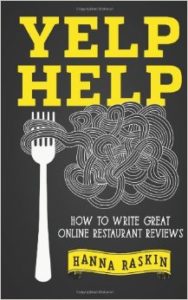If there’s any lesson to be learned from Arts and Culture in the Internet age of Rotten Tomatoes, Angie’s List, Kickstarter, Pinterest, and perhaps most visibly, Yelp, it is that online crowd-sourcing has become the engine that drives popular opinion. Whether it’s an indie film playing at the Uptown, a classic rock band’s reunion show at Xcel, or the new diner on Nicollet, our judgements and expectations are increasingly becoming a matter of online consensus.
This is the reality behind food critic Hanna Raskin’s new book, “Yelp Help: How to Write Great Online Reviews”, a succinct yet remarkably informative guide for amateur restaurant reviewers. Raskin, currently the food writer for the Charleston, S.C. Post & Courier, acknowledges that, increasingly, hungry patrons are turning to sites like Yelp (as opposed to professional reviews) for guidance on potential culinary destinations. Yet as someone who writes about restaurants for a living, Raskin is surprisingly optimistic and encouraging of aspiring Yelpers.
“By sticking to the principles outlined here, you’ll be able to write reviews which contribute to our collective culinary conversation and enrich your readers’ dining adventures,” Raskin writes in her introduction.
Indeed, the book is chock-full of important lessons for the iPhone-bearing foodie with dreams of Bourdain-esque gastronomical reflections.
Raskin’s most helpful instruction may be her list of do-nots. She examines common reviews gone awry; among them “The Underreported Review”, “The Cliched Review,” “The Flavorless Review” and, my personal favorite, “The Worst Review Ever!”:
“I ordered the nachos with picadillo and they were easily some of the best nachos I’ve ever had. Lots of gooey cheese, picadillo, jalapeños, beans. So yum. My husband had the pollo a la crema, which he loved and said it was the best he’d had.”
What makes this “the worst review ever?”
There’s no way of knowing how many times this reviewer has eaten nachos in her lifetime.
Indeed. And do you remember each individual nacho meal? Was this plate of nachos really better than the one you had last Tuesday at the end of your juice cleanse?
Throughout the book, Raskin excellently identifies missteps that many of us take for granted in the Age of the Quick Read. Emotional, situational, and regional biases abound in many Yelp reviews, and it’s important for us to identify them as writers and consumers. Just because you’re from, say, New York City and disapprove of the latest bagel place you’ve tried in Minneapolis, doesn’t mean the bagels aren’t halfway decent.
Also (and this put me in my place), avoid noting that anything is either full-of or lacking “flavor.” That means absolutely nothing.
Of particular note is a thorough explanation of how a restaurant works, the individual roles (from manager to busser), and exactly how much to tip (always 20%.) These essential factors to a well-informed review.
I enjoyed this book a lot. More substantive than a series of do’s and don’ts, “Yelp Help” is a soft commentary on the pitfalls of our hyper interconnectivity, and the effects of “trending” on every day society. The opinions of the masses, history teaches us, don’t always yield solid truths.
Pun intended, we should take food reviews with a grain of salt, and season our reviews well.
Hannah Raskin will be presenting “Yelp Help: How to Write Great Online Restaurant Reviews” on Sunday, February 15th at the St. Paul JCC, as part of the Twin Cities Jewish Book Series. Tickets are $30 and include a copy of the book.
Email me at [email protected]


